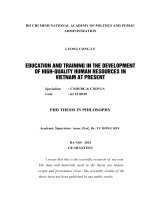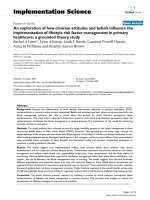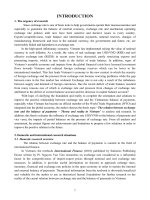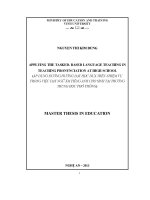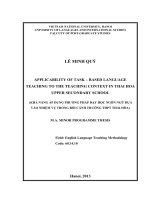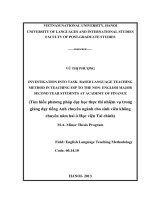The implementation of task based language teaching in EFL primary school classrooms a case study in vietnam
Bạn đang xem bản rút gọn của tài liệu. Xem và tải ngay bản đầy đủ của tài liệu tại đây (3.05 MB, 260 trang )
..
THE IMPLEMENTATION OF TASK-BASED LANGUAGE TEACHING
IN EFL PRIMARY SCHOOL CLASSROOMS: A CASE STUDY IN
VIETNAM
By
BUI LE DIEM TRANG
A thesis
submitted to Victoria University of Wellington
in fulfilment of the requirements for the degree of
Doctor of Philosophy in Applied Linguistics
Victoria University of Wellington, New Zealand
2019
ii
ABSTRACT
Research into the introduction of task-based language teaching (TBLT) in Asian
primary school classrooms is rare, despite curriculum initiatives in many Asian countries
promoting communicative and task-based teaching and learning. This study addresses this gap
by investigating the implementation of TBLT in EFL classrooms in primary schools in
Vietnam, a context hitherto under-research from a TBLT perspective. The research was
conducted in two phases.
Phase 1 was a multiple case study which used classroom observations, stimulated
recall and in-depth interviews to investigate how seven Vietnamese EFL primary school
teachers implemented speaking lessons and how they viewed the lessons. The results showed
that all teachers followed the presentation-practice-production (PPP) sequence specified in the
textbooks, but that they independently incorporated communicative activities into the lessons.
The teachers’ view of the PPP lessons varied but they shared a concern about the mechanical
nature of the PPP lessons.
Phase 2 investigated the implementation of two task-based lessons redesigned from
PPP speaking lessons in a textbook by three teachers who participated in Phase 1 of the study.
The data were collected from classroom observations, stimulated recall and in-depth
interviews with the teachers, interviews with pupils, and recordings of task performances by
nine pairs of learners. The results showed that all three teachers successfully carried out the
two task-based lessons and reported a higher level of learner engagement and communication
in their classes. Analysis of pupil interview data reveals evidence to support the teachers’
views. All pupils expressed interest in the task-based lessons with stronger pupils affirming
the scaffolding role of the pre-tasks and communicative value of the main tasks. Weaker
pupils reported challenges of completing the main tasks due to lack of pre-teaching of the
target structural patterns. Analysis of task interaction data showed that all dyads worked
consistently towards completing the main tasks in the task-based lessons, although the
achieved outcomes varied slightly. They were able to assist each other to co-construct their
utterances, correct their own errors and help correct each other’s errors, negotiate for meaning
to overcome comprehension difficulties and use L1 to foster task completion. All of these
strategies were found to facilitate task completion and provided a fruitful context for language
development. In sum, the results point to the viability of TBLT in the Vietnamese EFL
primary school context. They contribute to an understanding of the implementation of TBLT
in authentic classrooms and the nature of task interaction among EFL primary school pupils.
iii
DEDICATION
Dedicated to the memory of my mother, Le Thi Bay, who
selflessly devoted her life to the personal and academic growth
of her children
(1956-2010)
iv
ACKNOWLEDGEMENTS
First of all, I would like to express my deepest gratitude to my primary supervisor,
Associate Professor Jonathan Newton, for his strategic guidance, constructive criticism, and
patience throughout the PhD process. His confidence in me and my research kept me
motivated. I would also like to thank my secondary supervisor Dr. Jean Parkinson for her
enthusiasm, kindness and moral support throughout the project.
I am especially indebted to the New Zealand Scholarships for granting me a doctoral
scholarship to pursue this study. Without this support this thesis would not have been
possible. I am also grateful for the financial support provided by the Faculty of Humanities
and Social Sciences which allowed me to carry out data collection in Vietnam and present this
research abroad.
I am grateful to the Vietnamese teacher participants for their time and support. I would
also like to thank the pupils for participating in my research and the parents for allowing them
to participate. My sincere thanks also go to my colleagues and former students at An Giang
University for their invaluable help during my data collection.
I am grateful to the staff at the School of Linguistics and Applied Language Studies
(LALS) of Victoria University of Wellington (VUW) for creating a supportive and friendly
academic environment. Special thanks go to Bernie Hambleton, Janet Attrill, and Matthew
Vink for their administrative assistance.
I would like to thank VUW student advisors, particularly Dr. Deborah Laurs, and
Language Learning Centre (LLC) staff member, Dr. Diego Navarro, for their useful advice on
my writing. I am thankful to my officemates and all of my Vietnamese friends for their
friendship and kindness.
Finally, I cannot express sufficient gratitude to my entire family, who are always
standing beside me to provide their support. I deeply want to thank my father, my parents-inlaw, my sisters and brothers for encouraging and supporting me to pursue this PhD study. My
heartfelt thanks go to my dear friends, Le Nguyen and Hue Tran, for their encouragement and
wholehearted support, to my beloved husband, Khoa Nguyen, for taking care of my father
during my absence and for always being there for me, and to our beloved son, Khoi Nguyen,
for his company and care during my PhD journey. I cannot thank you enough, my dearest
friends, husband and son!
v
vi
TABLE OF CONTENTS
ABSTRACT ............................................................................................................................. iii
DEDICATION......................................................................................................................... iv
ACKNOWLEDGEMENTS ..................................................................................................... v
TABLE OF CONTENTS ....................................................................................................... vii
LIST OF TABLES .................................................................................................................. xii
LIST OF FIGURES ............................................................................................................... xiii
ABBREVIATION USED IN THE THESIS ........................................................................ xiv
TRANSCRIPTION SYMBOLS USED IN THE THESIS .................................................. xv
CHAPTER 1
INTRODUCTION......................................................................................... 1
1.1 Introduction ...................................................................................................................... 1
1.2 Aims for the study ............................................................................................................ 3
1.3 Research context ............................................................................................................... 3
1.4 Significance of the study .................................................................................................. 5
1.5 Overview of the research .................................................................................................. 6
1.6 Organization of the thesis ................................................................................................. 7
CHAPTER 2 LITERATURE REVIEW: TASKS, THEORETICAL BASIS FOR
TASK-BASED LANGUAGE TEACHING, TASK-BASED METHODOLOGY AND
CLASSROOM TASK IMPLEMENTATION ....................................................................... 9
2.1 Introduction ...................................................................................................................... 9
2.2 Tasks and task types ......................................................................................................... 9
2.2.1 Defining tasks ............................................................................................................ 9
2.2.2 Task types ................................................................................................................ 11
2.3 Theoretical perspectives on task-based learning ............................................................ 13
2.3.1 Cognitive perspectives ............................................................................................. 14
2.3.2 Sociocultural perspective ......................................................................................... 16
2.4 Task-based methodology ................................................................................................ 20
2.4.1 Frameworks for lesson design and focus on form in a task sequence ..................... 20
2.4.2 Strong and weak forms of TBLT ............................................................................. 22
2.4.3 Role of teachers and learners in TBLT .................................................................... 24
2.5 Research on TBLT implementation ............................................................................... 26
2.5.1 Studies of TBLT implementation outside Asia ....................................................... 27
2.5.2 Studies of TBLT implementation in Asia ............................................................... 28
2.6 Research on TBLT for young learners (YLs) ................................................................. 34
vii
2.6.1 Studies on TBLT for YLs in ESL contexts ............................................................. 34
2.6.2 Studies on TBLT for YLs in EFL contexts ............................................................. 36
2.7 Implementation of task-based teaching in primary classrooms ..................................... 39
2.8 Summary and rationale for the study.............................................................................. 42
CHAPTER 3
METHODOLOGY ..................................................................................... 45
3.1 Introduction .................................................................................................................... 45
3.2 Interpretivist research paradigm ..................................................................................... 45
3.3 Research design .............................................................................................................. 46
3.3.1 Qualitative research ................................................................................................. 46
3.3.2 Case study approach ................................................................................................ 47
3.4 Research setting .............................................................................................................. 51
3.4.1 Context of the study................................................................................................. 51
3.4.2 Gaining access ......................................................................................................... 51
3.4.3 Teacher and pupil participants ................................................................................. 53
3.4.3.1 Teacher participants ......................................................................................... 53
3.4.3.2 Pupil participants ............................................................................................. 55
3.4.4 Ethical considerations .............................................................................................. 56
3.5 Preliminary data collection procedures .......................................................................... 57
3.5.1 Phase 1 study ........................................................................................................... 58
3.5.2 Phase 2 study ........................................................................................................... 58
3.6 Data collection methods (Phases 1 and 2) ...................................................................... 61
3.6.1 Classroom observation ............................................................................................ 61
3.6.1.1 Video-audio recordings .................................................................................... 63
3.6.1.2 Field notes ........................................................................................................ 64
3.6.2 Interviews ................................................................................................................ 65
3.6.2.1 Stimulated recall and in-depth interviews with teachers.................................. 65
3.6.2.2 Group interviews with pupils in Phase 2 .......................................................... 67
3.6.3 Summary of data collection for Phases 1 and 2....................................................... 69
3.7 Data analysis (Phases 1 and 2) ....................................................................................... 71
3.7.1 Teachers’ implementation of the PPP speaking textbook lessons (Phase 1)........... 71
3.7.2 Teachers’ perceptions of the PPP lessons (Phase 1)................................................ 73
3.7.3 Teachers’ implementation of the task-based lessons and their evaluation of the
lessons (Phase 2)............................................................................................................... 74
3.7.4 Pupils’ perceptions of their experience with the task-based lessons (Phase 2) ....... 75
3.7.5 Pupils’ task-based interaction data (Phase 2) .......................................................... 76
viii
3.7.5.1 Co-construction ................................................................................................ 79
3.7.5.2 Self- and other-correction ................................................................................ 80
3.7.5.3 Negotiation for meaning ................................................................................... 83
3.7.5.4 L1 use as a scaffold and functions of L1 use .................................................... 85
3.7.5.5 Inter-coder reliability ....................................................................................... 87
3.8 Strategies to enhance research trustworthiness .............................................................. 87
3.8.1 Credibility ................................................................................................................ 87
3.8.2 Dependability .......................................................................................................... 88
3.8.3 Confirmability ......................................................................................................... 89
3.8.4 Transferability ......................................................................................................... 89
3.9 Role of the researcher ..................................................................................................... 90
CHAPTER 4 PHASE 1: THE IMPLEMENTATION OF TEXTBOOK SPEAKING
LESSONS ................................................................................................................................ 93
4.1 Introduction .................................................................................................................... 93
4.2 Overview of the textbook series and a specific textbook unit ........................................ 93
4.3 Analysis of the speaking textbook lessons ..................................................................... 95
4.4 Teachers’ implementation of the speaking textbook lessons ....................................... 100
4.4.1 Presentation phase ................................................................................................. 102
4.4.1.1 Vocabulary-based activities ........................................................................... 103
4.4.1.2 Teacher-led dialogue practice and explicit target structure explanations..... 106
4.4.2 Practice phase ........................................................................................................ 110
4.4.2.1 Teacher-led drill practice ............................................................................... 110
4.4.2.2 Pair work practice .......................................................................................... 112
4.4.3 Production phase ................................................................................................... 114
4.5 Teachers’ views of the PPP speaking lessons .............................................................. 119
4.6 Discussion of teachers’ implementation of the speaking lessons ................................. 124
4.7 Summary of Phase 1 findings ....................................................................................... 127
CHAPTER 5
LESSON DESIGN .................................................................................... 129
5.1 Introduction .................................................................................................................. 129
5.2 Reflecting on Phase 1 results ........................................................................................ 129
5.3 Preparing for the redesign............................................................................................. 130
5.4 Redesigning the PPP speaking lessons ......................................................................... 132
5.4.1 Task-based lesson 1 ............................................................................................... 134
5.4.2 Task-based lesson 2 ............................................................................................... 138
5.5 Reflecting on the redesign ............................................................................................ 143
ix
CHAPTER 6 PHASE 2: THE IMPLEMENTATION OF TWO TASK-BASED
LESSONS .............................................................................................................................. 147
6.1 Introduction .................................................................................................................. 147
6.2 Teacher profiles ............................................................................................................ 147
6.3 Teachers’ implementation of the task-based lessons.................................................... 150
6.3.1 Teacher Nam.......................................................................................................... 150
6.3.2 Teacher Nhu .......................................................................................................... 157
6.3.3 Teacher Lan ........................................................................................................... 164
6.3.4 Discussion of the implementation of the task-based lessons ................................. 170
6.3.4.1 Implementation of the task-based lessons ...................................................... 170
6.3.4.2 Teachers’ evaluation of their implementation of the task-based lessons ....... 172
6.4 Pupils’ perceptions of the two task-based lessons ........................................................ 175
6.4.1 Nam’s pupils (LPG)............................................................................................... 175
6.4.2 Nhu’s pupils (MPG) .............................................................................................. 177
6.4.3 Lan’s pupils (HPG) ................................................................................................ 180
6.4.4 Discussion of pupil perception data ...................................................................... 182
6.5 Pupils’ performance of the main tasks in the task-based lessons ................................. 184
6.5.1 Amount and characteristics of pupils’ main-task interaction ................................ 184
6.5.2 Verbal interactional strategies the pupils used to complete the main tasks .......... 185
6.5.2.1 Co-construction .............................................................................................. 186
6.5.2.2 Self- and other-corrections ............................................................................. 191
6.5.2.3 Negotiation for meaning (NfM) ...................................................................... 198
6.5.2.4 L1 use as a scaffold ........................................................................................ 202
6.5.3 Discussion of the task performance data ............................................................... 207
6.5.3.1 Characteristics of the task-interaction ........................................................... 207
6.5.3.2 Verbal interactional strategies in the task performances ............................... 208
6.6 Summary of Phase 2 findings ....................................................................................... 213
CHAPTER 7 CONCLUSION: SUMMARY OF FINDINGS AND IMPLICATIONS,
LIMITATIONS, AND FUTURE RESEARCH DIRECTIONS ....................................... 215
7.1 Introduction .................................................................................................................. 215
7.2 Summary of findings .................................................................................................... 215
7.2.1 Phase 1 ................................................................................................................... 215
7.2.2 Phase 2 ................................................................................................................... 216
7.3 Implications .................................................................................................................. 218
7.3.1 Pedagogical implications ....................................................................................... 218
7.3.2 Methodological implications ................................................................................. 221
x
7.3.3 Theoretical implications ........................................................................................ 222
7.4 Limitations and future research directions ................................................................... 222
7.5 Concluding remarks ...................................................................................................... 224
REFERENCES ..................................................................................................................... 227
APPENDICES....................................................................................................................... 243
xi
LIST OF TABLES
Table 1. Participant teachers’ profiles ...................................................................................... 54
Table 2. Overview and timeline of the research ....................................................................... 57
Table 3. Classroom observation scheme in Phase 1 ................................................................. 61
Table 4. Classroom observation scheme in Phase 2 ................................................................. 62
Table 5. Summary of data collection for Phases 1 and 2 ......................................................... 70
Table 6. An example of coding of classroom observation and stimulated recall interview data
.................................................................................................................................................. 73
Table 7. Coding of self-and other-correction strategies and their associated features ............. 81
Table 8. Design of a textbook unit ........................................................................................... 94
Table 9. The procedures of implementing the PPP speaking lessons .................................... 101
Table 10. The two task-based versions of the PPP speaking lessons ..................................... 133
Table 11. Nam’s lessons ......................................................................................................... 150
Table 12. Nhu’s lessons .......................................................................................................... 157
Table 13. Lan’s lessons .......................................................................................................... 164
Table 14. Frequency of c-units ............................................................................................... 185
Table 15. Occurrence of co-construction provided by peers and teachers ............................. 187
Table 16. Occurrence of self- and other-corrections in response to non-target-like utterances
................................................................................................................................................ 191
Table 17. Uptake from other-correction ................................................................................. 192
Table 18. Correction type and linguistic focus ....................................................................... 193
Table 19. Occurrence of NfM strategies ................................................................................ 199
Table 20. Amount of L1 and L2 use by c-units ...................................................................... 202
Table 21. Functions that the first language L1 served ............................................................ 204
xii
LIST OF FIGURES
Figure 1. Willis’s (1996) framework for TBLT ....................................................................... 21
Figure 2. Overview of the case studies .................................................................................... 50
Figure 3. An example of textbook speaking lesson 1 ............................................................... 96
Figure 4. An example of textbook speaking lesson 2 .............................................................. 98
Figure 5. Textbook presentation phase .................................................................................. 135
Figure 6. Pre-task phase ........................................................................................................ 135
Figure 7. Textbook practice phase ......................................................................................... 136
Figure 8.1 Class 4A timetable ............................................................................................... 137
Figure 8.2 Class 4B incomplete timetable ............................................................................. 137
Figure 9.1 Class 4B timetable ................................................................................................ 137
Figure 9.2 Class 4A incomplete timetable ............................................................................. 137
Figure 10. Textbook production activity ............................................................................... 138
Figure 11. Post-task activity .................................................................................................. 138
Figure 12. Presentation activity ............................................................................................. 139
Figure 13. Input-based listening task for the pre-task phase ................................................. 139
Figure 14. Textbook practice activity .................................................................................... 140
Figure 15.1 Class 4A timetable ............................................................................................. 141
Figure 15.2 Class 4B worksheet ............................................................................................ 141
Figure 16.1 Class 4B timetable ............................................................................................. 142
Figure 16.2 Class 4A worksheet ............................................................................................ 142
Figure 17. Textbook production activity ............................................................................... 143
Figure 18. Post-task activity .................................................................................................. 143
Figure 19. Mindmaping the school subjects (Nhu’s lesson) .................................................. 158
Figure 20. Classifying task .................................................................................................... 158
Figure 21. Mindmaping the school subjects (Lan’s lesson) ................................................... 165
Figure 22. Language focus of corrections .............................................................................. 194
xiii
ABBREVIATION USED IN THE THESIS
CEFR
Common European Framework of References for Languages
CLIL
Content and Language-Integrated Learning
CLT
Communicative Language Teaching
EFL
English as a Foreign Language
ELT
English Language Teaching
ESL
English as a Second Language
L1
First Language (Mother Tongue)
L2
Target Language (second, third or foreign)
NNS
Non-Native speakers
LRE
Language-Related Episode
PPP
Presentation-Practice-Production
TBLT
Task-based Language Teaching
TSLT
Task-supported Language Teaching
ZPD
Zone of Proximal Development
NfM
Negotiation for Meaning
CF
Corrective Feedback
NF
Negative Feedback
SCT
Socio-Cultural Theory
YLs
Young learners
xiv
TRANSCRIPTION SYMBOLS USED IN THE THESIS
Symbol
Meaning
()
English translation of Vietnamese L1 utterances
[]
Researcher’s explanations/comments
…
Unfilled pause (one second or longer)
Uhm
Filled pause
[…]
Deleted text
xxx
Unintelligible speech
a-b-c-d-e-f
The speaker is spelling out the word
?
The speaking is asking a question or raising the intonation
.
Falling intonation
,
Continuing intonation
Upper case
Word emphasis
(e.g., SCIENCE)
!
Emotional emphasis at the end a phrase/sentence
/ˈsʌb.dʒekt /
Phonetic transcription (International phonetic alphabet (IPA))
T
Teacher
P1
Pupil 1
P2
Pupil 2
Ps
Many pupils
R
Researcher
xv
This page is intentionally left blank
xvi
CHAPTER 1
INTRODUCTION
1.1 Introduction
Vignette: My experience of primary English education in Vietnam
I work at a Vietnamese university in the Mekong delta province. One of the key goals
of the university is to train teachers to work in local schools in the province and in some
neighbouring provinces. Over the years in my job, I have taught a range of courses to both
English and non-English major students. In early 2012, I had my first experience training
primary school pre-service teachers. I was tasked with delivering a course in primary English
education called “English teaching methodology”. The course was divided into two phases.
The first phase was theoretical where I introduced and evaluated methods and techniques in
English language teaching. The second phase was practical where students worked on lesson
planning and teaching practices to prepare for their teaching practicum in local schools. To
better prepare my students and myself for their practicum, in the trimester before the second
phase started, I travelled to local schools with my colleagues to observe their student teachers
doing their practicum, which took place earlier than mine. These field trips were important to
me as I was able to put together a better picture of the current teaching practices being used in
different primary schools across my province.
But more than this, I enjoyed these field trips to the local primary schools. The English
lessons I observed at the schools were very different from the ones when I first started my
education in English. Classes were well equipped with all sorts of resources such as television
sets, CD cassette players, computers and even interactive whiteboards. The classroom
atmosphere was also very exciting with games, songs and chants, and with pupils engaging in
English through different play activities. Being better informed about the existing practices, I
was encouraged and excited to start the second phase of the course. In light of what I had
observed, I devoted a lot of time to designing and practicing play activities similar to the ones
I had observed in action.
By the end of the course in late 2012, my student teachers started their own practicum.
I visited some of them to see how they were performing and how their supervisors 1 were
assessing their practice. I was so happy to observe my student teachers successfully carrying
out the activities they designed. I was even happier to hear their supervisors praise them for
1
Supervisors for student teachers are chosen among experienced teachers at local primary schools.
1
their use of enjoyable and creative games, for their ability to use the games to motivate
children, for their skilful classroom management, and most of all for the fact that the play
activities my students designed and implemented engaged children in using the target
structures from the textbooks. As a result, many of my students received excellent grades for
their teaching performances.
The course ended with success and everyone seemed satisfied and pleased and for
good reason: we had worked very hard and the evaluations of our work were positive.
However, I began to feel a little uneasy about it all. I could not help wondering about the
extent to which learning had actually occurred in these lessons. I kept thinking about the local
supervisors’ assessment of my teacher students’ teaching. For example, although my teacher
students’ supervisors emphasized the need to provide a variety of play activities to keep
children interested and to enhance classroom interaction, most of these activities we planned
and I observed were the type of play activities where children practiced, in quite a controlled
context, using pre-specified forms. I realised that the supervisors and, to a large extent, the
teacher students, and even myself interpreted children’s enjoyment of activities as proof that
learning was taking place. Also, we all seemed to believe that communicative language
learning takes place as soon as children do pair-work activities and that repetitive practice of
target vocabulary and structures through these activities will lead to communicative
competence.
My uneasy feelings were confirmed in subsequent school visits in later years, which
urged me to further explore communicative language learning and ways of ensuring that
learning is happening. My reading of the literature told me that the practices I had observed
focus learners’ attention on language forms while a better way to promote communicative
competence is to focus learners’ attention on meaning (i.e., using language to express their
meaning rather than just reproducing the target language). I also learned that there are other
ways to design play activities which may provide more effective communicative
opportunities. Thus, motivated by an interest in primary English education, guided by an
enthusiasm to ensure that the teaching and learning are both interesting and effective, and
driven by a desire to be the best teacher trainer I can be, I decided to embark on my research
journey which would help me bridge sound theory with innovative practice.
Below I outlined the research aims for this research.
2
1.2 Aims for the study
The primary aim of the current study is to investigate the viability of adopting TBLT
in EFL primary school classrooms in the Vietnamese context. Specifically, the study first
aims to investigate the implementation of the existing textbook speaking lessons before
examining the viability of implementing the task-based version of the lessons. The current
study delves into an area of previously limited exploration: EFL primary school pupils’
performance and perceptions of tasks. This study is especially timely as the Vietnamese
government is committed to making communicative outcomes a key goal for primary English
education. Broadly, it responds to a recent call for shifting the focus of TBLT research from
investigating the constraints to TBLT implementation to examining “the range of teachinglearning procedures available, the outcomes and the relative efficiency of the approach”
(Bygate, 2016, p. 397).
1.3 Research context
The introduction of English teaching at primary school levels has gained considerable
attention in East Asian countries, particularly in Vietnam. In these countries, English has
traditionally not been used as a main means of communication although it has been taught as
a foreign language in formal schooling (at the secondary level and beyond) for years
(Butler, 2015). To serve the country’s economic development goals, many Asian governments
have introduced English at the primary school level with the expectation that an early
introduction of English will better develop learners’ English ability (Butler, 2015). As English
curricula have been introduced or updated, many Asian countries (e.g., Hong Kong and
China) have adopted communicative and task-based language teaching as a leading means to
promote language learning in schools (Butler, 2015; Lai, 2015). The adoption of TBLT was
based on increasing theoretical and empirical evidence that TBLT improves communicative
confidence and skills of language learners. It does this by providing opportunities for needsdriven attention to and noticing of language forms in the context of meaningful language use
(Ellis, 2003;Willis & Willis, 2007).
Vietnam, along with many other Asian countries such as China, has made a strong
commitment to boosting the teaching and learning of English in primary schools to meet the
high demand for proficient users of English in the context of globalization and economic
integration. Driven by this commitment, over the last two decades, primary English education
in Vietnam has gone through significant reforms. Starting in 1997, because of the high
3
demand for English in big cities such as Ha Noi and Ho Chi Minh, English was first piloted as
an elective subject in primary schools from Grade 3 (when children are aged eight or nine)
with two 40-minute periods a week (Nguyen, 2011; Nguyen & Nguyen, 2007). In 2003, due
to a growing demand, English was officially approved as an optional subject from Grade 3 in
primary schools nationwide where there were adequate teaching resources and interest from
parents (Nguyen & Nguyen, 2007). Following this approval, a formal syllabus was produced
and, in the 2005-2006 school year, the first domestically produced textbook series Let’s learn
English 1,2,3 (Nguyen et al., 2010) was developed and taught in primary English classrooms
for two 40-minute periods per week (Le & Do, 2012).
In 2008, English was introduced as a compulsory subject in primary schools. At the
same time, Vietnam’s government issued Decision No. 1400/QD-TTg, approving a 20082020 national foreign languages project (NFLP) called “Teaching and learning foreign
languages in the national formal education system from 2008 to 2020” (Vietnamese Prime
Minister, 2008). The project aims to (1) to renovate the foreign language teaching and
learning at all school levels; (2) enhance the Vietnamese young generation to communicate
confidently and effectively in a foreign language (mainly English) so that they can study and
work in multi-lingual and multi-cultural environments; (3) meet the needs of the country’s
industrialization and modernization (Vietnamese Prime Minister, 2008). In December 2017,
the government approved amendments and supplements to the 2008-2020 NFLP. As part of
these approved amendments, the project has been extended to a new period from 2017 to
2025 to facilitate the achievement of the established goals (DanTri, 2017).
In an effort to work toward these established goals, in August 2010, a pilot primary
school English curriculum was issued. The curriculum stipulates that the English language is
to be a compulsory subject for the first time in primary schools starting from Grade 3, and is
to be taught for four periods (35-40 minutes each) per week. The curriculum adopts a
communicative language teaching approach and requires teachers to assess learning in terms
of learners’ abilities to communicate in English with a particular focus on the listening and
speaking skills. This assessment initiative reflects the government’s emphasis on promoting
young learners’ abilities to communicate in English across a range of contexts.
Accompanying the new curriculum is a new textbook series Tieng Anh 3-4-5 (Hoang
et al., 2015c) for Grades 3, 4 and 5, produced in collaboration with Macmillan Publishers and
introduced in 2013. In a recent evaluation of the new textbooks, Dang and Seals (2018)
reported that “the textbook design succeeds quite well in adopting a communicative language
teaching approach” (p.108). The new curriculum and accompanying textbooks are intended to
4
be adopted at schools with adequate facilities and teacher resourcing. To teach the curriculum,
teachers are required to attend English enhancement programs to achieve Level B2 or above
of the Common European Framework of References for Languages (CEFR) (Council of
Europe, 2001) in terms of their English proficiency (Vietnamese Prime Minister, 2008). They
are also required to attend training workshops which target a range of areas such as principles
of teaching English to young leaners, techniques of developing learners’ communicative
skills, language assessment, and integrating technology in language teaching. The 2008-2020
NFLP seeks, through this curriculum, to enhance the English proficiency of primary school
pupils so that they can obtain a foundation Level A1 of the CEFR at the end of their primary
English education.
Seven years after the introduction of the new primary English curriculum, research
into its implementation remains scant, with only two studies to date looking specifically at the
actual implementation of these curricular innovations (Le & Do, 2012; Nguyen, 2011). These
studies, however, were able to identify important issues with the implementation process. For
example, they reported that teachers followed the PPP approach for the teaching of English in
primary schools, which, “to some extent, limits the students’ interaction and communication
as they have little chance to be exposed to more authentic situations” (Nguyen, 2011, p. 239).
However, both studies investigated the implementation of the curriculum when teachers were
still using the old textbooks series Let’s learn English 1-2-3 (Nguyen et al., 2010). These
books were reported to “focus more on grammar and vocabulary than on communication” (Le
& Do, 2012, p. 108) and they were not sufficiently “grounded in an understanding of
children’s learning and language learning” (Moon, 2005, p. 53). Given the recent language
proficiency enhancement for teachers and their experiences with using the new textbooks,
research into the implementation of the new textbooks and how the communicativeness of the
textbook lessons can be enhanced is critical to the successful implementation of the new
curriculum.
1.4 Significance of the study
The current research is of significance in several ways. First, given the current
importance of primary English education in Vietnam to meet its recent national goals for
English language proficiency, the findings from this research provide grounds for potential
enhancement of primary English teaching and learning in Vietnam. Reporting on how
5
teachers are implementing the new curriculum and accompanying textbooks carries
implications for the on-going implementation of the new curriculum.
Second, this research adds to the steadily growing research on the implementation of
TBLT in authentic English classrooms. It is hoped that this research will contribute to the
professional knowledge of how TBLT can be implemented in Asian EFL primary school
contexts as well as providing insights for policy-making and improving the quality of
primary-school level English language teaching in general.
Third, this research considers the experience and perceptions of the key decision
makers, the teachers, while they are implementing PPP speaking lessons and task-based
versions of the lessons. It will, therefore, add to the literature on teacher and learner cognition
in the under-researched context of primary schools in Vietnam. An understanding of the
beliefs and contextual factors that shape the teachers’ instructional decisions can inform the
development of the pre-service and in-service teacher training, which can support more
effective curriculum implementation.
Finally, this research contributes to an under-researched area, namely young learners’
perspectives of tasks (Carless, 2012; Pinter, 2014, 2015). It provides a new understanding of
what aspects of tasks they enjoy and why, how they collaborate to complete tasks and what
they think they can learn from them.
1.5 Overview of the research
The current study investigates the implementation of TBLT in primary EFL
classrooms. The study consists of two phases. Phase 1 is a multiple case study investigating
the implementation of PPP textbook speaking lessons and teachers’ perceptions of the PPP
lessons. Motivated by Phase 1 results, Phase 2 explores how teachers implemented task-based
versions of the PPP speaking lessons in their classrooms, how learners perceived their
experiences of working with tasks, and ultimately what came out of task performance. The
study aims to address the following research questions (RQs):
Phase 1: Teacher implementation of the textbook speaking lessons
RQ1. (a) How did the teachers implement the textbook speaking lessons?
(b) How did they explain their implementation decisions?
RQ2. How did the teachers view the textbook PPP speaking lessons?
6
Phase 2: Teacher implementation of the task-based versions of the textbook
speaking lessons.
RQ1. (a) How did the teachers implement the task-based lessons?
(b) How did they evaluate their implementation of the task-based
lessons?
RQ2. How did the pupils perceive their experience of carrying out the two
task-based lessons?
RQ3. (a) How did the pupils perform the main tasks in the task-based
lessons?
(b) What verbal interactional strategies did they adopt to perform the
tasks?
1.6 Organization of the thesis
The thesis consists of seven chapters. This first chapter has introduced the thesis.
Chapter 2 deals with the relevant literature review. Chapter 3 presents the methodology for
both phases of the study, followed by Chapter 4 which reports on the results of teachers’
implementation of the PPP textbook speaking lessons and their perceptions of their
implementation decisions in particular and of the PPP lessons, in general. Chapter 5 acts as a
bridge detailing the rationale and the design of the task-based version of the PPP speaking
lessons. Chapter 6 discusses the results of the implementation of the task-based lessons. It
reports on teachers’ implementation and perceptions of the lessons and pupils’ perceptions of
the task-based lessons as well as their actual performance of the main tasks in the lessons.
Chapter 7 is the conclusion which summarises the main findings of the thesis, and discusses
pedagogical, methodological and theoretical implications. It also discusses important
limitations and proposes future research directions. The chapter ends with a concluding
statement.
7
This page is intentionally left blank
8
CHAPTER 2
LITERATURE REVIEW: TASKS,
THEORETICAL BASIS FOR TASK-BASED LANGUAGE
TEACHING, TASK-BASED METHODOLOGY AND
CLASSROOM TASK IMPLEMENTATION
2.1 Introduction
This study investigates the feasibility of implementing TBLT in primary schools in
Vietnam. Therefore, the purpose of this chapter is to critically evaluate the case for adopting
TBLT in this context. This chapter will start by reviewing different definitions of tasks in an
effort to decide on a working definition of tasks for this specific study. This will be followed
by a review of theoretical perspectives and research findings that have lent support to the use
of tasks for language learning. The next section will discuss task-based methodology with
respect to a framework for lesson design, approaches to teaching with tasks and the roles of
teachers in implementing TBLT. Next, research on implementing TBLT in real classrooms is
discussed. Since the current study involved young learners, the final section reviews research
on tasks for young learners in both ESL and EFL contexts. This includes a review of research
into implementing TBLT in primary classrooms, which then leads to the rationale for the
current study.
2.2 Tasks and task types
2.2.1 Defining tasks
One of the main aims of this study is to evaluate activities in textbook speaking
lessons and in teachers’ implementation of these lessons. It is, therefore, necessary to specify
what a task is and how it is different from traditional language teaching activities. In addition,
a clear understanding of this distinction is essential for the design and implementation of taskbased versions of the textbook speaking lessons for EFL in the Vietnamese primary school
classroom, which is another objective of the current study.
In the 1980s, as TBLT emerged out of communicative language teaching (CLT), the
term “task” was increasingly used in place of communicative activities (Skehan, 2003). CLT
is defined as “a broad approach to teaching that resulted from a focus on communication as
the organizing principle for teaching rather than a focus on mastery of the grammatical system
of the language” (Richards, 2001, p. 36). In other words, CLT is based on communicative
9




